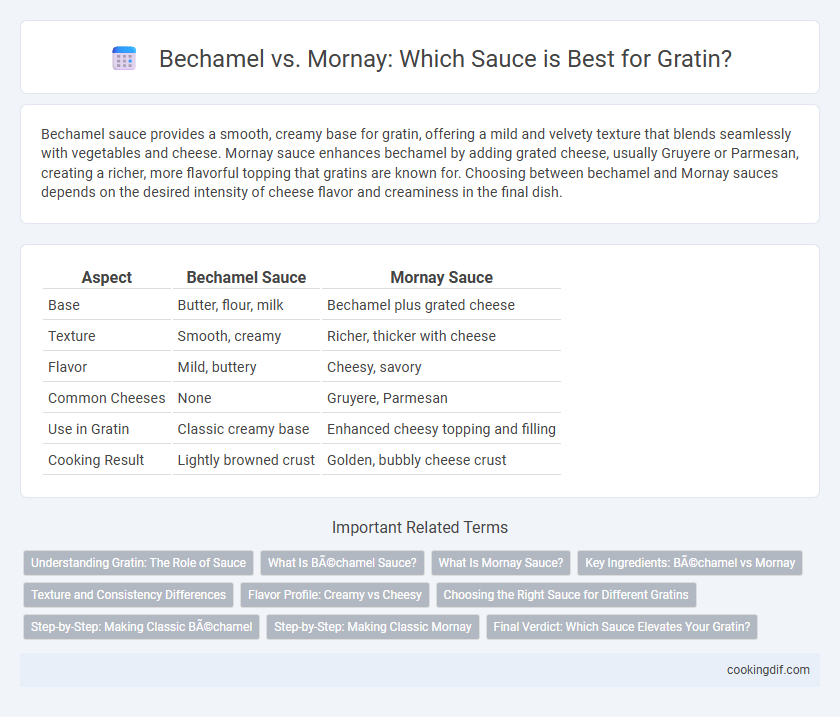Bechamel sauce provides a smooth, creamy base for gratin, offering a mild and velvety texture that blends seamlessly with vegetables and cheese. Mornay sauce enhances bechamel by adding grated cheese, usually Gruyere or Parmesan, creating a richer, more flavorful topping that gratins are known for. Choosing between bechamel and Mornay sauces depends on the desired intensity of cheese flavor and creaminess in the final dish.
Table of Comparison
| Aspect | Bechamel Sauce | Mornay Sauce |
|---|---|---|
| Base | Butter, flour, milk | Bechamel plus grated cheese |
| Texture | Smooth, creamy | Richer, thicker with cheese |
| Flavor | Mild, buttery | Cheesy, savory |
| Common Cheeses | None | Gruyere, Parmesan |
| Use in Gratin | Classic creamy base | Enhanced cheesy topping and filling |
| Cooking Result | Lightly browned crust | Golden, bubbly cheese crust |
Understanding Gratin: The Role of Sauce
Bechamel sauce serves as the creamy foundation for gratin, providing a smooth, velvety texture that binds the ingredients while enhancing their flavors. Mornay sauce, a bechamel enriched with grated cheese such as Gruyere or Parmesan, adds a rich, savory depth and a golden, bubbly crust when baked. Choosing between bechamel and Mornay influences the gratin's taste profile and texture, with Mornay delivering a more indulgent, cheesy finish ideal for vegetable or potato gratins.
What Is Béchamel Sauce?
Bechamel sauce, a classic French white sauce, is made from a roux of butter and flour cooked with milk to create a creamy, smooth base ideal for gratin dishes. It provides a mild, velvety texture that enhances the natural flavors of vegetables, potatoes, or seafood without overpowering them. When enriched with grated cheese, Bechamel transforms into Mornay sauce, adding richness and depth perfect for gratins requiring a golden, bubbly crust.
What Is Mornay Sauce?
Mornay sauce is a rich variation of bechamel sauce infused with grated cheese, typically Gruyere or Parmesan, enhancing the flavor and texture of gratin dishes. It provides a creamy, cheesy layer that melts beautifully over vegetables, potatoes, or seafood, adding depth and a golden crust when baked. This sauce transforms a classic bechamel into a savory, indulgent topping essential for achieving the signature gratin's creamy and browned perfection.
Key Ingredients: Béchamel vs Mornay
Bechamel sauce, made from butter, flour, and milk, provides a creamy, smooth base essential for classic gratin dishes. Mornay sauce builds on bechamel by incorporating grated cheese, typically Gruyere or Parmesan, adding a rich, savory depth that enhances the gratin's flavor and creates a golden, bubbly crust. The key difference lies in cheese integration, making Mornay ideal for gratins requiring a more pronounced cheesy taste.
Texture and Consistency Differences
Bechamel sauce offers a smooth, creamy texture with a medium consistency, ideal for binding gratin ingredients without overpowering their flavor. Mornay sauce, enriched with grated cheese, delivers a thicker, richer consistency that adds a slightly grainy texture and enhances the gratin's savory depth. The cheese melt in Mornay creates a velvety, gooey finish, contrasting with the silkier, more neutral profile of Bechamel.
Flavor Profile: Creamy vs Cheesy
Bechamel sauce offers a smooth, creamy texture with a subtle, buttery flavor that enhances gratin dishes without overpowering other ingredients. Mornay sauce, enriched with melted cheese such as Gruyere or Parmesan, delivers a rich, savory, and distinctly cheesy taste that intensifies the overall flavor of the gratin. Choosing between Bechamel and Mornay depends on whether a delicate creaminess or a bold, cheesy depth is desired in the finished dish.
Choosing the Right Sauce for Different Gratins
Bechamel sauce, made from butter, flour, and milk, creates a smooth, creamy base ideal for vegetable gratins like cauliflower or spinach, providing a subtle, rich flavor that complements the ingredients without overpowering them. Mornay sauce, a bechamel variant enriched with grated cheese such as Gruyere or Parmesan, adds a savory, cheesy depth perfect for gratins featuring potatoes, seafood, or mixed vegetables, offering a crisp golden crust after baking. Selecting between bechamel and Mornay depends on the desired flavor intensity and the specific gratin ingredients, ensuring the sauce enhances rather than masks the dish's natural taste.
Step-by-Step: Making Classic Béchamel
Classic Bechamel sauce for gratin begins by melting butter in a saucepan and whisking in an equal amount of flour to create a smooth roux, cooked until bubbling and pale but not browned. Gradually, warm milk is added while continuously whisking to prevent lumps, resulting in a creamy, velvety white sauce seasoned with salt, white pepper, and a touch of nutmeg. For Mornay sauce, grated Gruyere or Parmesan cheese is folded into the finished bechamel, enriching the gratin with a flavorful, cheesy dimension ideal for a golden crust.
Step-by-Step: Making Classic Mornay
Classic Mornay sauce, a creamy blend of Bechamel and cheese, transforms any gratin with its rich, velvety texture and deep flavor. Begin by preparing a smooth Bechamel with butter, flour, and warm milk, then gradually whisk in grated Gruyere and Parmesan until fully melted and combined. Finish by seasoning with nutmeg, salt, and white pepper, ensuring the sauce coats the gratin ingredients evenly for a luscious, golden crust after baking.
Final Verdict: Which Sauce Elevates Your Gratin?
Bechamel sauce offers a smooth, creamy texture that provides a classic, delicate base for gratins, enhancing the dish's subtle flavors without overpowering them. Mornay sauce, enriched with Gruyere or Parmesan cheese, introduces a rich, nutty depth that crisps beautifully under heat, creating a luscious, golden crust ideal for gratins like potatoes or cauliflower. Choosing Mornay elevates gratin to a decadent, flavorful experience, while Bechamel suits those seeking a lighter, more traditional option.
Béchamel vs Mornay for Gratin sauce Infographic

 cookingdif.com
cookingdif.com